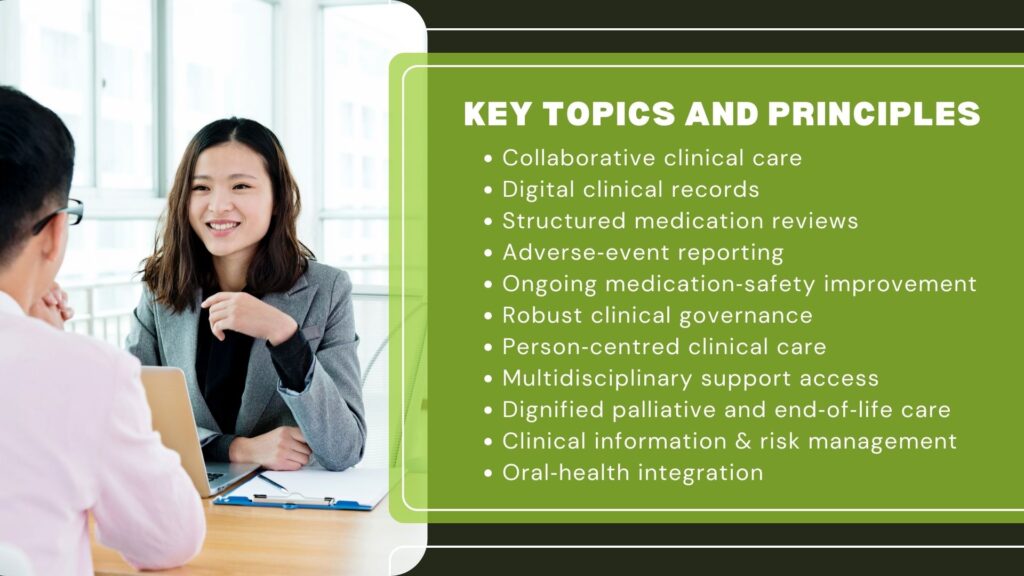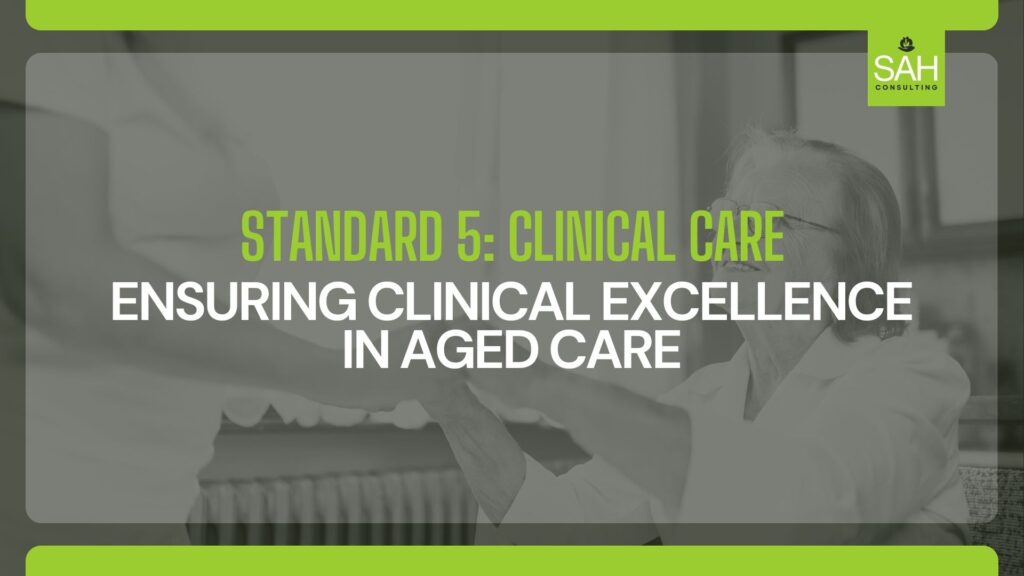Australia’s Support at Home Programme is reshaping aged‑care regulation. At its heart are the Strengthened Aged Care Quality Standards, and Standard 5 raises the bar for clinical care. As older Australians live longer with multiple, often complex, conditions, this Standard becomes the benchmark for safe, evidence‑based care delivered in genuine partnership with the people who receive it. So, when will the new Aged Care Standards be implemented? This year. As such, meeting these expectations will be key to achieving accreditation standards in aged care.
What Standard 5 Means
These are the voices that guide Standard 5:
For the elderly: “I get the right clinical care for me.”
For care workers: “I understand the clinical needs of the person I’m caring for.”
According to the Aged Care Quality and Safety Commission, Standard 5 requires providers to deliver person‑centred, inclusive, safe, effective and coordinated clinical care that enhances quality of life, reablement and independence. It emphasises risk, choice and partnership: older people stay active decision‑makers, retaining the right to take informed risks where they wish. Category 5 & 6 providers—and Category 4 services that deliver any form of clinical care—must follow these accreditation standards in aged care.
Key Topics and Principles

Providers must weave the following clinical‑care pillars into everyday practise:
- Collaborative clinical care – Clear, documented roles, responsibilities and protocols with external health professionals.
- Digital clinical records – Progress toward (or full use) of an interoperable electronic clinical‑information system.
- Structured medication reviews – Firm rules and schedules for regular medication reviews.
- Adverse‑event reporting – Mandatory notification of medicine or vaccine incidents to the Therapeutic Goods Administration.
- Ongoing medication‑safety improvement – Continuous checks that medicines are stored, prescribed and administered safely.
- Robust clinical governance – An organisation‑wide framework that drives safety, quality and accountability.
- Person‑centred clinical care – Tailoring interventions to each individual’s needs, culture, goals and preferences.
- Multidisciplinary support access – Timely access to the full range of health and allied health professionals.
- Dignified palliative and end‑of‑life care – Upholding respect, comfort and cultural wishes at life’s final stage.
- Clinical information & risk management – Accurate records plus proactive identification and mitigation of clinical risks.
- Oral‑health integration – Routine oral‑health assessment and care within overall practise.
Required Outcomes and Actions
Standard 5 contains 7 outcomes supported by 35 actions that together create the clinical‑governance framework for safe, high‑quality, person‑centred clinical care across residential and home‑care settings.
Outcome 5.1 – Clinical Governance
A robust, organisation‑wide clinical‑governance system underpins every aspect of clinical care, embedding evidence‑based practice, clear accountability and continuous quality improvement.
Actions:
- 5.1.1 Clinical‑governance system – establish and resource a governance structure that sets policy, assigns roles and monitors performance.
- 5.1.2 Quality & safety monitoring – collect, analyse and act on clinical‑quality data (incidents, indicators, sentinel events).
- 5.1.3 Risk management & escalation – identify clinical risks, implement controls and ensure timely escalation.
- 5.1.4 Partnership & scope of practise– define how workers and external health professionals collaborate within agreed scopes.
- 5.1.5 Review & improve – routinely evaluate governance effectiveness and drive ongoing improvement.
Outcome 5.2 – Preventing & Controlling Infections
Providers minimise infection risks and antimicrobial resistance through stewardship and infection‑prevention systems tailored to the clinical services delivered.
Actions:
- 5.2.1 Antimicrobial stewardship (AMS) – implement an AMS programme that aligns with evidence‑based practise.
- 5.2.2 Infection‑prevention & control (IPC) – embed aseptic technique, device management and surveillance processes for all clinical procedures.
Outcome 5.3 – Safe & Quality Use of Medicines
Medication‑management systems ensure medicines optimise benefit and minimise harm, with transparent information‑sharing and timely reviews.
Actions:
- 5.3.1 Medication‑management system – provide accurate medicines information, safe administration and ready access to prescribed medicines.
- 5.3.2 Medication reviews – conduct reviews at commencement, transitions, annually and when clinical triggers arise.
- 5.3.3 Allergy & adverse‑reaction recording – document and update allergies and side‑effects.
- 5.3.4 High‑risk medicines – identify, monitor and mitigate risks, including psychotropic use.
- 5.3.5 Adverse‑event reporting – report medicine and vaccine events to the Therapeutic Goods Administration.
- 5.3.6 System evaluation – regularly audit and improve the medication‑management system.
Outcome 5.4 – Comprehensive Care
Multidisciplinary, person‑centred clinical care is planned, delivered and reviewed to optimise quality of life, reablement and function.
Actions:
- 5.4.1 Partnered assessment & planning system – set goals of care with the individual and supporters.
- 5.4.2 Comprehensive clinical assessment – initial, periodic and trigger‑based assessments (incl. GP review, risk profiling, equipment needs).
- 5.4.3 Referral & access pathways – facilitate timely access to relevant health and specialist services.
- 5.4.4 Co‑ordinated multidisciplinary delivery – clarify roles, ensure after‑hours/urgent care and share information.
- 5.4.5 Monitoring & reassessment – detect and respond to clinical change or deterioration.
Outcome 5.5 – Safety of Clinical Care Services
High‑impact and high‑prevalence risks are systematically identified, monitored and managed to prevent avoidable harm.
Actions:
- 5.5.1 Risk‑management system – overarching system for prioritised clinical risks.
- 5.5.2 Choking & swallowing safety – manage dysphagia during meals, oral care and medication.
- 5.5.3 Continence care – promote dignity, skin integrity and continence support.
- 5.5.4 Falls & mobility – prevent falls, provide post‑fall care and monitor injuries.
- 5.5.5 Nutrition & hydration – screen for malnutrition/dehydration and respond to unplanned weight change.
- 5.5.6 Mental health – promote wellbeing and respond to distress, self‑harm or suicidal ideation.
- 5.5.7 Oral health – ensure assessments, daily hygiene and prompt response to decline.
- 5.5.8 Pain management – assess, monitor and provide 24‑hour access to pain relief.
- 5.5.9 Pressure injury & wounds – conduct skin inspections and manage wounds promptly.
- 5.5.10 Sensory impairment – address hearing, vision and balance loss with suitable aids.
Outcome 5.6 – Cognitive Impairment
Clinical care meets the complex needs of people experiencing delirium, dementia or other cognitive impairment, focusing on risk reduction and behaviour support.
Actions:
- 5.6.1 Identify & respond to complex needs – mitigate risks and monitor deterioration.
- 5.6.2 Collaboration & understanding – work with the person and supporters to tailor strategies.
- 5.6.3 Behaviour‑change prevention & response – minimise triggers and address underlying causes of changed behaviour.
Outcome 5.7 – Palliative & End‑of‑Life Care
Individuals receive dignified, culturally‑safe palliative and end‑of‑life care that manages pain and symptoms and supports families.
Actions:
- 5.7.1 Recognition & preparation – identify palliative phase early and adapt care to changing needs.
- 5.7.2 Continuing end‑of‑life planning – revisit goals, advance‑care documents and treatment choices.
- 5.7.3 Comprehensive palliative care – deliver comfort‑focused, multidisciplinary care with timely access to equipment, medicines and specialist support.
- 5.7.4 Last days of life processes – manage rapid changes, ensure 24‑hour symptom control, essential care and avoid unwanted hospital transfers.
These outcomes and actions form the mandatory framework providers must embed by 2025 to meet Standard 5: Clinical Care of the Strengthened Aged Care Quality Standards.
Demonstrating Conformance
Regulators look for proof that systems are documented, practised and reviewed—not just that policies exist. To show that that you meet Standard 5, you need to:
- Document: Maintain up‑to‑date clinical‑governance frameworks, digital records procedures, infection‑control protocols and medication‑safety policies.
- Monitor: Use audits, incident data and consumer feedback to track how well processes work and where risks emerge.
- Partner: Involve older people (and families) in care planning and feedback loops.
- Observe & verify: Supervisors should routinely watch care, checking that staff escalate deterioration promptly and follow evidence‑based practise.
- Improve: Feed insights back into training, protocols and governance reports to create a cycle of continuous improvement.
Reflective Questions for Providers
These questions help aged care providers assess how effectively they’re meeting the requirements of Strengthened Quality Standard 5: Clinical Care. By addressing them, providers can meet accreditation standards in aged care:
- How do you make sure the key topics of this Standard show up in the care and services you provide to the people you support?
- How do you work together with people receiving care to shape how their clinical care and services are provided?
- How do you ask people receiving care for feedback about their experience with clinical care?
How SAH Consulting Simplifies Support at Home Registration
At SAH Consulting we specialise in guiding providers through the Support at Home registration maze. Our audits, policies and training resources map directly to the Strengthened Quality Standards—especially Standard 5’s 35 actions.
We provide evidence templates and mock assessments to ensure you’re fully prepared for audits. With ready-to-go documentation and practise inspections, we help you feel confident and audit-ready from the start.
Final Thoughts
Standard 5 is one of the most important rules that care providers need to follow to meet accreditation standards in aged care. It’s a clinical cornerstone of the new Support at Home registration process. Its 35 actions translate directly into what surveyors will test—so getting them right is non‑negotiable.
Providers who invest now in strong clinical governance, digital records, safe medicine practises, and genuine partnerships with older people will enter 2025 with confidence. Need a guiding hand? Contact SAH Consulting to fast‑track your registration or elevate your clinical‑care systems today.
